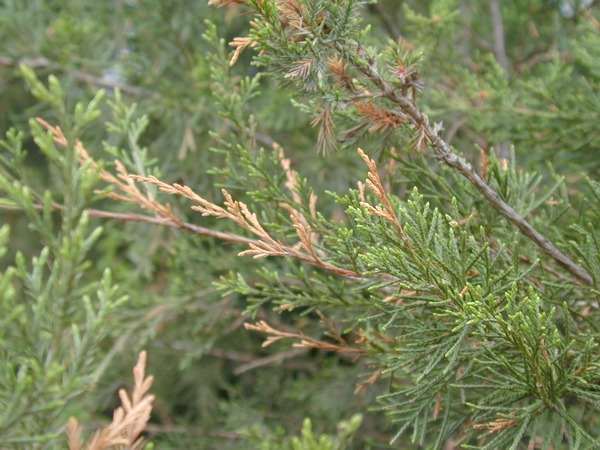Phomopsis Blight of Junipers
 Causal Agent
Causal Agent
Phomopsis juniperovora
Hosts
Juniper, cedar, and arborvitae.
Symptoms
 Infected trees will exhibit browning of the foliage and dying of twigs and branches.
Small black fruiting bodies of the fungus are formed on this dead tissue. Conidia
are produced in these structures and when moisture is present masses of conidia will
ooze out to form tendrils or horns. The conidia are spread by rain and various other
means such as mechanical disruption and insects. The fungus enters the plant through
wounds as well as unbroken tissue. The browning of the needles and twigs begins at
the tips and progesses downward toward the stem. Moisture is an important factor in
disease spread and severity. Nurseries and Christmas tree plantations that utilize
overhead irrigation usually have more severe disease problems because wetting of the
foliage results in earlier spread of the conidia.
Infected trees will exhibit browning of the foliage and dying of twigs and branches.
Small black fruiting bodies of the fungus are formed on this dead tissue. Conidia
are produced in these structures and when moisture is present masses of conidia will
ooze out to form tendrils or horns. The conidia are spread by rain and various other
means such as mechanical disruption and insects. The fungus enters the plant through
wounds as well as unbroken tissue. The browning of the needles and twigs begins at
the tips and progesses downward toward the stem. Moisture is an important factor in
disease spread and severity. Nurseries and Christmas tree plantations that utilize
overhead irrigation usually have more severe disease problems because wetting of the
foliage results in earlier spread of the conidia.
Control
Good sanitation is important in reducing disease occurrence in nurseries. Clean cultivation, good drainage and roguing are important techniques that should be followed. Fungicides are usually applied as protectants and a regular schedule of funigcide sprays must be applied to prevent the penetration of the fungus into the plants. Homeowners are encouraged to use at least two sprays, one when the disease is first noticed and another 10 to 14 days later. For best control, infected twigs should be pruned prior to the application of the fungicide. Please contact your local county extension office for current information.
